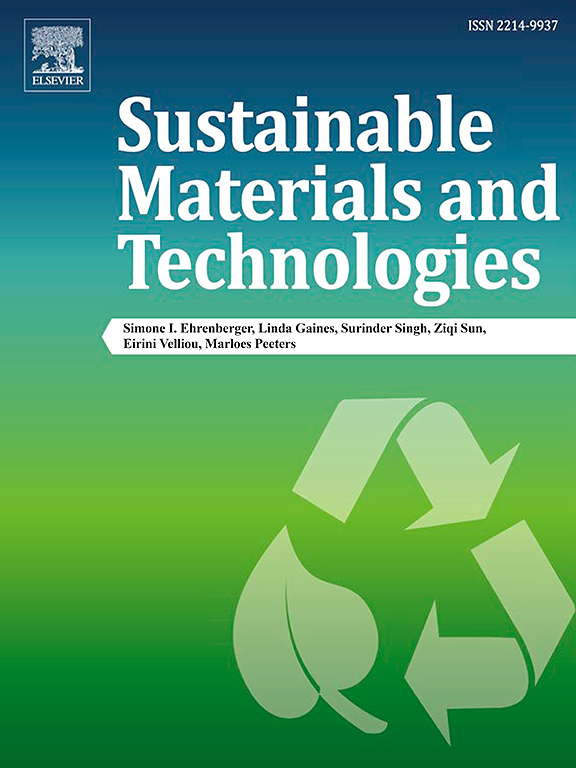Direct recycling of anode active material from Li-ion batteries using TiNb2O7 anode
IF 8.6
2区 工程技术
Q1 ENERGY & FUELS
引用次数: 0
Abstract
As the demand for large lithium-ion batteries (LIBs) for automotive and other applications rapidly grows, recycling of electrode materials has become essential owing to the large amount of waste material generated by battery manufacturing (e.g., battery scrap) and end-of-life (EOL) batteries. While there have been many studies on recycling of cathode materials, we propose a direct recycling process for anode material using TiNb2O7 (TNO) as the active material, as it offers high capacity and long life. Calcination was introduced to separate the anode active material from the current-collecting foil, and a regeneration method was investigated for TNO anodes from scrap and EOL battery waste. After calcination, the active material can be easily separated from the aluminum current-collecting foil owing to the binder disappearing. The structure of the active material was investigated using X-ray diffraction and scanning electron microscopy. TNO active material recycled from scrap and EOL was found to maintain the structure of virgin material. A cell was fabricated using recycled TNO and cell performance was evaluated. The cell capacity and rate capacity were found to be almost equivalent to those of virgin material. In terms of the carbon footprints of products (CFP), CO2 emissions during the recycling process were compared between recycled material and virgin material, and it was found that CO2 emissions were reduced to 0.7-CO2eq/kg for scrap material and 3.8-CO2eq/kg for EOL waste material, compared with 4.8-CO2eq/kg for virgin material. Thus, the feasibility of low CO2 emissions during TNO anode direct recycling was confirmed in principle. A simple and low CO2 emission recycling loop can thus be constructed by employing a stable TNO active material structure and direct-recycling process with calcination.
使用 TiNb2O7 阳极直接回收锂离子电池的阳极活性材料
随着汽车和其他应用领域对大型锂离子电池(LIB)需求的快速增长,由于电池制造过程中产生的大量废料(如电池废料)和报废(EOL)电池,电极材料的回收变得至关重要。虽然已有许多关于正极材料回收利用的研究,但我们提出了一种使用 TiNb2O7 (TNO) 作为活性材料的正极材料直接回收利用工艺,因为它具有高容量和长寿命的特点。我们采用煅烧法将阳极活性材料与集流箔分离,并研究了从废料和 EOL 电池废料中提取 TNO 阳极材料的再生方法。煅烧后,由于粘合剂消失,活性材料很容易从铝集电箔中分离出来。使用 X 射线衍射和扫描电子显微镜研究了活性材料的结构。结果发现,从废料和废弃物中回收的 TNO 活性材料保持了原始材料的结构。使用回收的 TNO 制作了电池,并对电池性能进行了评估。结果发现,电池容量和速率容量几乎与原始材料相当。在产品碳足迹(CFP)方面,比较了回收材料和原始材料在回收过程中的二氧化碳排放量,发现废料的二氧化碳排放量降低到 0.7-CO2eq/kg,EOL 废料的二氧化碳排放量降低到 3.8-CO2eq/kg,而原始材料的二氧化碳排放量为 4.8-CO2eq/kg。因此,TNO 阳极直接回收过程中低 CO2 排放的可行性原则上得到了证实。因此,通过采用稳定的 TNO 活性材料结构和煅烧直接回收工艺,可以构建一个简单且二氧化碳排放量低的回收循环。
本文章由计算机程序翻译,如有差异,请以英文原文为准。
求助全文
约1分钟内获得全文
求助全文
来源期刊

Sustainable Materials and Technologies
Energy-Renewable Energy, Sustainability and the Environment
CiteScore
13.40
自引率
4.20%
发文量
158
审稿时长
45 days
期刊介绍:
Sustainable Materials and Technologies (SM&T), an international, cross-disciplinary, fully open access journal published by Elsevier, focuses on original full-length research articles and reviews. It covers applied or fundamental science of nano-, micro-, meso-, and macro-scale aspects of materials and technologies for sustainable development. SM&T gives special attention to contributions that bridge the knowledge gap between materials and system designs.
 求助内容:
求助内容: 应助结果提醒方式:
应助结果提醒方式:


